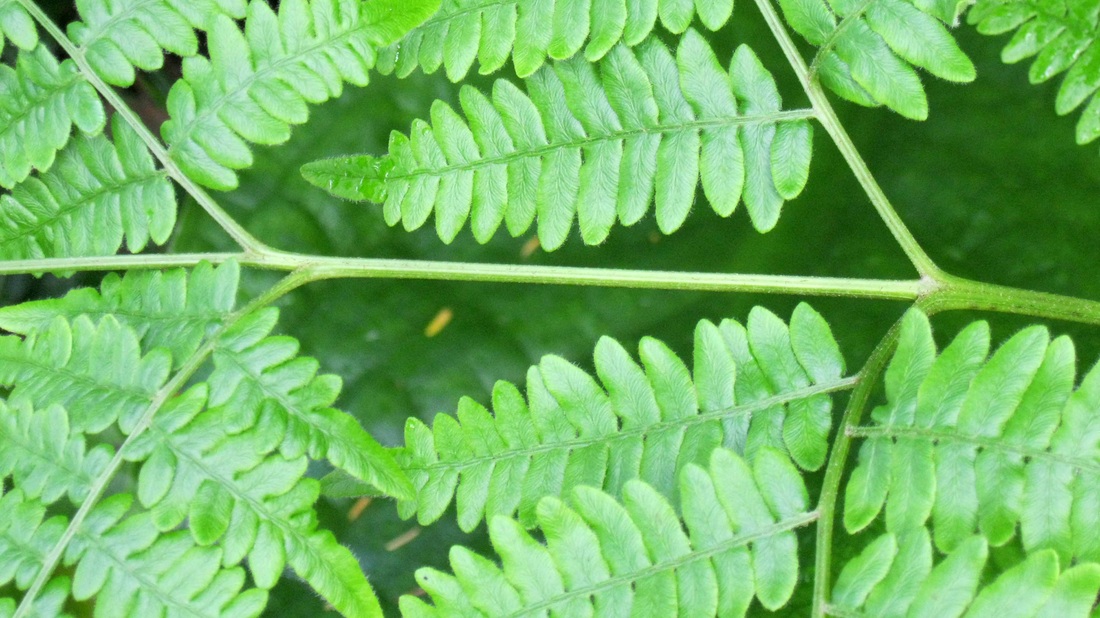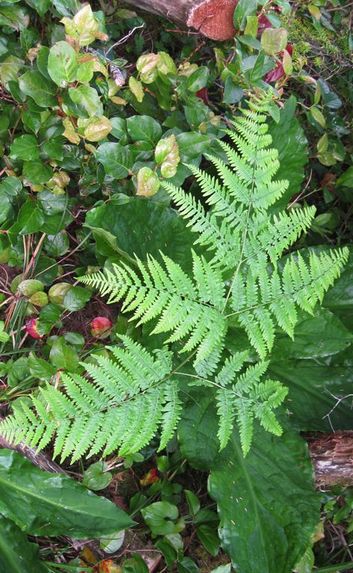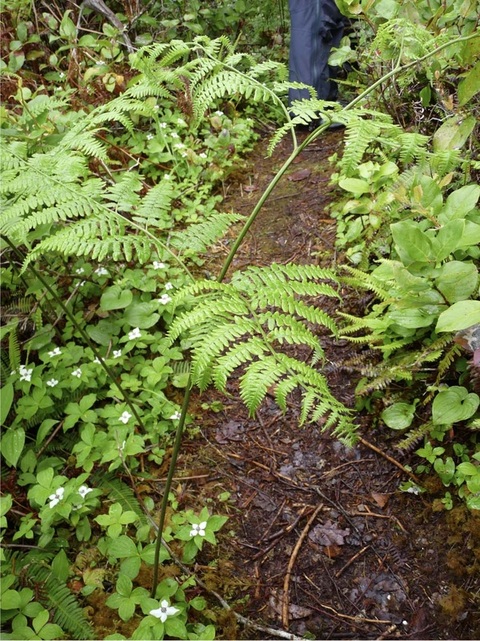Bracken fern, western brackenfern • Pteridium aquilinum
• Nuxalk - sacsakwmlhpnk (specifically rhizomes)
Identification
Bracken fern is large and upright, with triangular fronds reaching heights of 3-5 m. Each frond grows separately from an underground branching rhizome. Several triangular to lance-shaped blades (leaflets) branch out from each frond. These blades are comprised of smaller pinnate leaflets; the whole frond is 2-3 times pinnate.
Habitat & Range
Bracken fern grows in a multitude of habitats from low to subalpine elevations, including forests, meadows, clearings, avalanche paths, sandy soils, acidic soils, and roadsides. It is often abundant or even weedy, and flourishes in disturbed sites. Its deep rhizomes allow it to survive fires, meaning it is often abundant in newly burnt areas. Bracken fern is a cosmopolitan species found around the world. It occurs across much of North America as well as Eurasia, Africa, South America, and Australia.
Similar Species
Both spiny wood fern (Dryopteris expansa) and lady fern (Athyrium filix-femina ssp. cyclosorum) appear quite similar to bracken fern. They are distinguished by their clustered fronds, as opposed to bracken fern's single fronds.
Human Uses
Various parts of bracken fern were traditionally used and consumed by coastal First Nations groups. The Nuxalk, Saanich, Kwakwaka'wakw, Nuu-chah-nulth and Haida all harvested the rhizomes in the summer or fall, and either roasted or steamed them, removing the outer skin and central fibres before eating them. They were usually eaten with fish eggs or oil, because they are constipating. The fiddleheads (curled new growth in the spring) were also boiled and eaten.
**NOTE: Although parts of the plant were eaten by many coastal groups, the leaves are poisonous. They can cause livestock poisoning and are implicated in stomach cancer.
iNaturalist
https://www.inaturalist.org/taxa/52681-Pteridium-aquilinum
Bracken fern is large and upright, with triangular fronds reaching heights of 3-5 m. Each frond grows separately from an underground branching rhizome. Several triangular to lance-shaped blades (leaflets) branch out from each frond. These blades are comprised of smaller pinnate leaflets; the whole frond is 2-3 times pinnate.
Habitat & Range
Bracken fern grows in a multitude of habitats from low to subalpine elevations, including forests, meadows, clearings, avalanche paths, sandy soils, acidic soils, and roadsides. It is often abundant or even weedy, and flourishes in disturbed sites. Its deep rhizomes allow it to survive fires, meaning it is often abundant in newly burnt areas. Bracken fern is a cosmopolitan species found around the world. It occurs across much of North America as well as Eurasia, Africa, South America, and Australia.
Similar Species
Both spiny wood fern (Dryopteris expansa) and lady fern (Athyrium filix-femina ssp. cyclosorum) appear quite similar to bracken fern. They are distinguished by their clustered fronds, as opposed to bracken fern's single fronds.
Human Uses
Various parts of bracken fern were traditionally used and consumed by coastal First Nations groups. The Nuxalk, Saanich, Kwakwaka'wakw, Nuu-chah-nulth and Haida all harvested the rhizomes in the summer or fall, and either roasted or steamed them, removing the outer skin and central fibres before eating them. They were usually eaten with fish eggs or oil, because they are constipating. The fiddleheads (curled new growth in the spring) were also boiled and eaten.
**NOTE: Although parts of the plant were eaten by many coastal groups, the leaves are poisonous. They can cause livestock poisoning and are implicated in stomach cancer.
iNaturalist
https://www.inaturalist.org/taxa/52681-Pteridium-aquilinum
References
Ethnobotany - Ferns and Fern-Allies. Washington State Department of Transportation. Accessed 06/04/2013.
Pojar, J. and MacKinnon, A. (2005). Plants of Coastal British Columbia, Revised. Vancouver, BC: Lone Pine Publishing. P. 420.
Pteridium aquilinum (L.) Kuhn. bracken fern; western brackenfern. In Klinkenberg, Brian. (Ed.). E-Flora BC: Electronic Atlas of the Plants of British Columbia. Lab for Advanced Spatial Analysis, Department of Geography, University of British Columbia, Vancouver. Accessed on 03/04/2013.
Authors and editors of page
Chanda Brietzke, Kelly Fretwell, and Brian Starzomski (2013).
Ethnobotany - Ferns and Fern-Allies. Washington State Department of Transportation. Accessed 06/04/2013.
Pojar, J. and MacKinnon, A. (2005). Plants of Coastal British Columbia, Revised. Vancouver, BC: Lone Pine Publishing. P. 420.
Pteridium aquilinum (L.) Kuhn. bracken fern; western brackenfern. In Klinkenberg, Brian. (Ed.). E-Flora BC: Electronic Atlas of the Plants of British Columbia. Lab for Advanced Spatial Analysis, Department of Geography, University of British Columbia, Vancouver. Accessed on 03/04/2013.
Authors and editors of page
Chanda Brietzke, Kelly Fretwell, and Brian Starzomski (2013).







